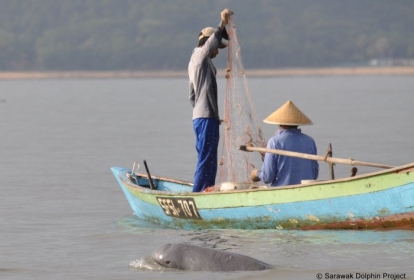The consequences of climate change are now understood to be widespread, affecting many different aspects of the environment. The impact on cetaceans is believed to be equally broad, and climate change is also likely to exacerbate existing threats, for example habitat loss, pollution and disease.
The IWC first considered the implications of climate change for its work in the early 1990s. Historically, it has been difficult to provide meaningful advice on how to manage the threat to cetaceans. This is because the availability of key information and predictive power were both limited. The situation has changed dramatically in recent years, as IWC’s knowledge of cetacean biology, and ability to model population trends have improved.
In 2022 the Commission established a new Intersessional Group on Climate Change to assess the latest information on cetacean populations, provide advice on tools to mitigate its impact and build resilience and develop an IWC climate change response programme.
This follows five workshops on climate change, the first in 1996 and the second in 2010 in response to the 4th Assessment Report from the Intergovernmental Panel for Climate Change. The third, in 2011, focused on potential impacts to small cetaceans, and identified those living in restricted habitats such as estuaries, rivers and shallow waters as finding it harder to adapt to changing circumstances. A fourth in 2014 assessed the impacts of increased marine activities on cetaceans in the Arctic where climate change has already significantly altered the marine ecosystem. The fifth was a virtual meeting held in 2021 to review the latest scientific research and assess both observed and predicted effects of climate change on cetaceans, including on their prey and habitats. The group received a report on the latest results from the Intergovernmental Panel on Climate Change which gave a stark assessment of the current situation.
Research now shows strong evidence of distributional shifts in some species, which are likely to be the consequence of the changing climate. Whilst this may suggest some ability to adapt, the extent is unknown and may be forcing cetaceans into new waters containing new threats, for example moving into shipping lanes or areas of concentrated fishing activity. In related work, the IWC Scientific Committee of the IWC is also working to explore the ecosystems services that whales provide, including how they may trap and store carbon, and help in the distribution of nutrients.
The most recent 2021 workshop agreed a series of recommendations including a prioritisation of future research on regions experiencing intense climate change impacts, and which are also key cetacean habitats. The group also stressed the importance of sharing information and making best use of available resources, including through partnerships and collaboration, and improving methods to utilise results from detailed small-scale studies to make wider inferences.
The value of whales to the ecosystem: carbon sinks and the 'whale pump'
The IWC has long recognised the importance of whales in the functioning of ecosystems. The Commission adopted Resolutions directing work on the issue in 2016 and 2018, and the Conservation and Scientific Committees have both focused efforts on different aspects of this topic. In recent years, a range of global organisations have contributed to a rapid increase in knowledge and interest in the role played by whales in ecosystems. In 2019, the International Monetary Fund published a report exploring the economic value of whales in ecosystem functioning. The report estimated that each great whale sequesters approximately 33 tons of carbon, equivalent to 30,000 trees, and suggested an average monetary value of $2M for each animal. In 2022, the Sixth Assessment Report of the International Panel on Climate Change proposed whales as potential blue carbon ecosystems.
In 2021 the IWC held a virtual workshop to review existing economic and social valuation techniques for the ecosystem services provided by cetaceans, and identify potential new methods for assessing their contributions. Participants included social scientists and economists as well as specialists in marine ecology and cetacean biology, and the group developed a prioritised list of recommendations to address knowledge gaps and advance research, as well as suggesting potential approaches for incorporating the contribution of cetaceans to marine ecosystem function into the decision-making processes of the IWC and other relevant organisations.
|
How do whales contribute to reducing carbon in the atmosphere? Firstly, just as trees capture carbon in the terrestrial ecosystem, whales capture carbon in the ocean ecosystem. A large whale can store a vast amount of carbon over the course of a life that may last 100+ years. When the animal dies it sinks to the sea-bed, ‘locking-in’ this large carbon store for centuries.
Whale excrement performs a second important service to the ecosystem. It acts as a fertiliser for phytoplankton, a microscopic creature that lives at the ocean’s surface and is very effective at both capturing carbon and releasing oxygen. The whale’s waste contains the iron and nitrogen that phytoplankton need to grow. Whales feed in deep water and come to the surface to breathe, bringing these valuable minerals up to the phytoplankton in a process known as ‘the whale pump.’
|
Read more
To read the report of the 2021 Workshop on Climate Change click here.
To read the report of the 2014 Workshop on Impacts of Increased Marine Activities on Cetaceans in the Arctic click here.
To read the report of the 2011 Workshop on Small Cetaceans and Climate Change click here.
To read the report of the 2010 Workshop on Cetaceans and Climate Change click here.


